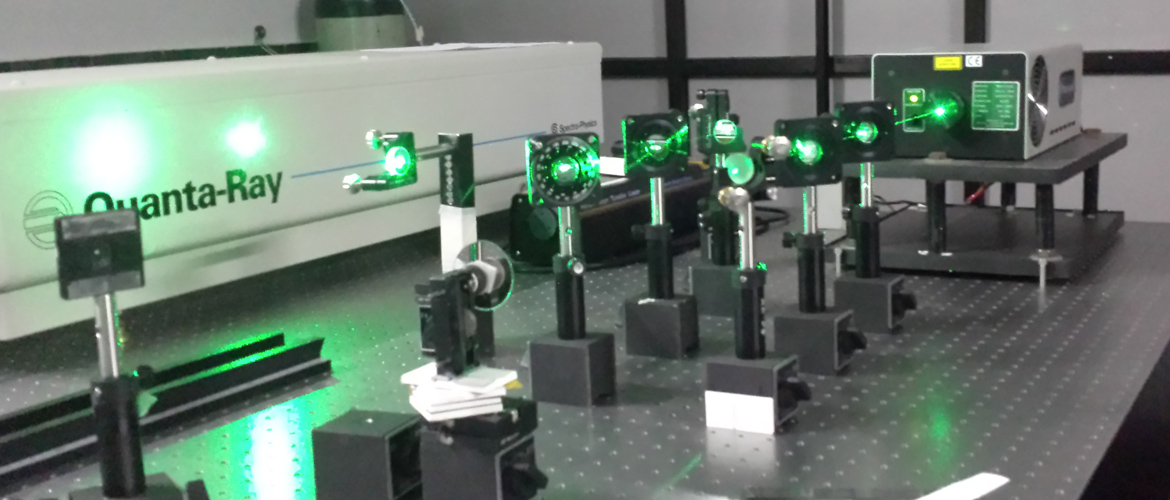History of the Nonlinear Optics Research Laboratory in the Department of Physics, SUST
Introduction:
The quest for research in the field of Nonlinear Optics, at Shahjalal University of Science and Technology, started nearly two decades ago. It was 1996 and the field of Nonlinear Optics was totally new in Bangladesh.Nonlinear interaction of light with matter deals with the light-induced changes of the optical properties of a medium.

In general, the observation of nonlinear optical effects requires the applications of lasers. Numerous nonlinear optical phenomena have been discovered since the discovery of lasers in 1961. Nonlinear Optics (a revolutionary extension of conventional linear optics promoted by laser technology) is a relatively new field with very attractive applications. Each nonlinear process involves the intense laser light inducing a nonlinear response in the medium and then the medium reacting to modify the optical fields in a nonlinear way.
The initiation:
1996: Theoretical courses and the involvement of faculty members
Experimental physics research in Bangladesh is restricted due to the expenses involved. We, at SUST, thought that it might be possible to do experimental work in the field of Nonlinear Optics. It was initially started because it primarily offered the scope of affordable experimental work. In 1996, it was not yet the age of internet in Bangladesh and even finding books on Nonlinear Optics itself, was a challenge! Books were collected through personal contact. It was encouraging to see the interest of the students in this relatively new exciting field.
Theoretical courses in Nonlinear Optics were designed and introduced in the undergraduate and Masters Curriculum. The faculty members involved, started dreaming and planning an experimental laboratory.
Involved
Faculty members:
Students:
Studies (theoretical or experimental)
Conferences or seminars attended
Publications:
The first laboratory:
1999: Funded by the Ministry of Science and Technology, Bangladesh
In the meantime, the search for funding for an optics laboratory was initiated. In 1999, an initial small grant was given by the Ministry of Science and Technology. The first Ar-Ion laser was procured in 2000. A home-made optical table was made and initial experiments started. A course on the fundamentals of Lasers was also added to the curriculum to enhance the understanding of the students.
Involved
Faculty members:
Students:
Studies (theoretical or experimental)
Conferences or seminars attended
Publications:
The evolution:
2010:Funded by HEQEP well-equipped Nonlinear Optics Laboratory, established and a strong research group with faculty researchers and students was established.
In 2010, the University Grants Commission started the Higher Education Quality Enhancement Projects (HEQEP), funded by the World Bank and the Government of Bangladesh. The Nonlinear Optics researchers wrote a proposal titled “Optical Behavior and Structure Analysis of Nonlinear Materials” and were awarded a grant. This project made it possible to set up a highly sophisticated optics laboratory in the Department of Physics at Shahjalal University of Science and Technology (SUST). This has led to the establishing of a strong research group with faculty researchers and students.
This well-equipped Nonlinear Optics Laboratory, established under HEQEP, is presently one of the best equipped laboratories in the country. Through the use of state of the art equipment, lasers and modern experimental apparatus, the faculty members and students are constantly being challenged to learn and perform the research in different aspects of the field. Many students have already been awarded their M.S degrees. M.Phil and Ph.D students are currently working towards the completion of their degrees. Results of experimental work have been presented in national and international conferences and journals.
Involved
Faculty members:
Students:
Studies (theoretical or experimental)
Conferences or seminars attended
Publications:
The Enhancement:
2015: University-Industry Research Collaboration
It was in 2015 that the researchers in this laboratory decided to look into the possible potential applications in this field. The expertise developed in the measurements of the NLO properties of new materials, within a short time, encouraged them to submit another proposal under the University-Industry Research Collaboration of HEQEP. This project titled “Innovative Biomarker Detection System using Nonlinear Optics” was awarded to the Department of Physics in 2016. Currently a Nonlinear BioOptics Laboratory is being installed for exploring the possible proposed applications.
It was a dream to set up a modern Nonlinear Optics Research Laboratory at SUST. This was made a reality due to the funding provided by HEQEP. This facility has provided a platform for the students to develop electronic devices like micro controlled chopper for laser beam chopping, translation stage, photodiode based detectors, data acquisition system, remote laser control system and other devices as part of their project assignments. This laboratory has thus enhanced and encouraged students to also develop their electronics and computational skills. Computer interfacing for signal detection and the development of calculation software for customized experiments are some of the additional challenges that have been faced and addressed.
Involved
Faculty members:
Students:
Studies (theoretical or experimental)
Conferences or seminars attended
Publications:
The future ahead is definitely one of exciting and new possibilities for researchers of this laboratory in this area.
